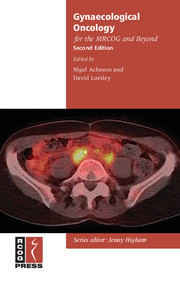Book contents
- Frontmatter
- Contents
- About the authors
- Preface
- Introduction to the second edition
- Abbreviations
- 1 Basic epidemiology
- 2 Basic pathology of gynaecological cancer
- 3 Preinvasive disease of the lower genital tract
- 4 Radiological assessment
- 5 Surgical principles
- 6 Role of laparoscopic surgery
- 7 Radiotherapy: principles and applications
- 8 Chemotherapy: principles and applications
- 9 Ovarian cancer standards of care
- 10 Endometrial cancer standards of care
- 11 Cervical cancer standards of care
- 12 Vulval cancer standards of care
- 13 Uncommon gynaecological cancers
- 14 Palliative care
- 15 Emergencies and treatment-related complications in gynaecological oncology
- Appendix 1 FIGO staging of gynaecological cancers
- Index
8 - Chemotherapy: principles and applications
Published online by Cambridge University Press: 05 August 2014
- Frontmatter
- Contents
- About the authors
- Preface
- Introduction to the second edition
- Abbreviations
- 1 Basic epidemiology
- 2 Basic pathology of gynaecological cancer
- 3 Preinvasive disease of the lower genital tract
- 4 Radiological assessment
- 5 Surgical principles
- 6 Role of laparoscopic surgery
- 7 Radiotherapy: principles and applications
- 8 Chemotherapy: principles and applications
- 9 Ovarian cancer standards of care
- 10 Endometrial cancer standards of care
- 11 Cervical cancer standards of care
- 12 Vulval cancer standards of care
- 13 Uncommon gynaecological cancers
- 14 Palliative care
- 15 Emergencies and treatment-related complications in gynaecological oncology
- Appendix 1 FIGO staging of gynaecological cancers
- Index
Summary
Introduction
Chemotherapy is used in a variety of situations in gynaecological oncology (Box 8.1). The best known is in the treatment of gestational trophoblastic disease, where single-agent treatment is highly successful for low-risk cases and multi-agent regimens are used in the treatment of higher-risk cases. Gestational trophoblastic disease is one of the few solid tumours that is regularly cured by chemotherapy alone. It is, however, an uncommon tumour. The most common use in gynaecology is in the treatment of epithelial and non-epithelial ovarian cancers.
BOX 8.1 USES OF CHEMOTHERAPY IN GYNAECOLOGICAL ONCOLOGY
• Adjuvant and neoadjuvant treatment in ovarian cancer
• Primary treatment of gestational trophoblastic disease
• Relapsed ovarian cancer
• Advanced or relapsed cervical cancer
• Chemoradiation in cervical and vulval cancer
• Advanced and relapsed endometrial cancer
• Sarcomas and non-epithelial ovarian tumours
Chemotherapy is used in an adjuvant setting (after a primary surgical procedure that may or may not have removed all macroscopic disease), in a 'neoadjuvant' fashion (prior to a surgical procedure) and in relapsed or recurrent disease. In cervical cancer, chemotherapy is usually reserved for selected cases of relapsed disease, although, latterly, it has been employed concurrently with radiotherapy in primary treatment (chemoradiation). This principle is also being applied to selected cases of vulval cancer, although less frequently.
Keywords
- Type
- Chapter
- Information
- Gynaecological Oncology for the MRCOG and Beyond , pp. 103 - 114Publisher: Cambridge University PressPrint publication year: 2011

